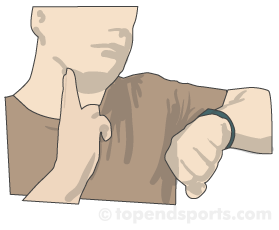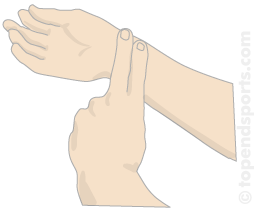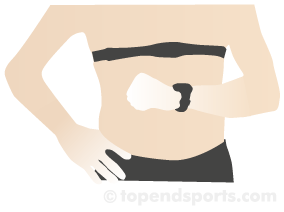 Your heart rate can be taken at any spot on the body at which an artery is close to the surface and a pulse can be felt. The most common places to measure heart rate using the palpation method is at the wrist (radial artery) and the neck (carotid artery). Other places sometimes used are the elbow (brachial artery) and the groin (femoral artery). You should always use your fingers to take a pulse, not your thumb, particularly when recording someone else's pulse, as you can sometimes feel your own pulse through your thumb.
Your heart rate can be taken at any spot on the body at which an artery is close to the surface and a pulse can be felt. The most common places to measure heart rate using the palpation method is at the wrist (radial artery) and the neck (carotid artery). Other places sometimes used are the elbow (brachial artery) and the groin (femoral artery). You should always use your fingers to take a pulse, not your thumb, particularly when recording someone else's pulse, as you can sometimes feel your own pulse through your thumb.Manual Method
 Carotid Pulse (neck) - To take your heart rate at the neck, place your first two fingers on either side of the neck. Be careful not too press to hard, then count the number of beats for a minute.
Carotid Pulse (neck) - To take your heart rate at the neck, place your first two fingers on either side of the neck. Be careful not too press to hard, then count the number of beats for a minute. - Radial Pulse (wrist) - place your index and middle fingers together on the opposite wrist, about 1/2 inch on the inside of the joint, in line with the index finger. Once you find a pulse, count the number of beats you feel within a one minute period.
Monitor Method

A heart rate monitor or ECG/EEG can be used to get a more accurate heart rate measurement. This is particularly important during exercise where the motion of exercise often makes it hard to get a clear measurement using the manual method. Using a heart rate monitor is also useful when you wish to record heart rate changes over short time periods, where the heart rate may be changing. Many heart rate monitors are able to record the heart rate values to be reviewed later or downloaded to a computer.
Many heart rate monitors require at least a little body perspiration between the chest strap and the skin for best conduction of the signal. Make sure that there is a good connection between the chest strap and your chest, and you can add some water or other fluid to increase the conductivity too.
No comments:
Post a Comment